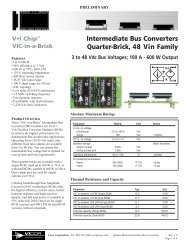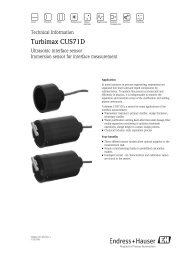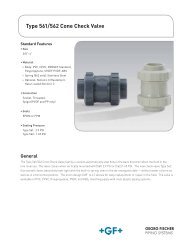Title Reference Design Report for a 12.6 W, TRIAC ... - ThomasNet
Title Reference Design Report for a 12.6 W, TRIAC ... - ThomasNet
Title Reference Design Report for a 12.6 W, TRIAC ... - ThomasNet
You also want an ePaper? Increase the reach of your titles
YUMPU automatically turns print PDFs into web optimized ePapers that Google loves.
11-Feb-13RDR-347 <strong>12.6</strong> W Dimmable LED Driver Using LYT4313E4.5 Output RectificationThe trans<strong>for</strong>mer secondary winding is rectified by D6 and filtered by capacitors C12, C13,and C14.For designs where higher ripple is acceptable and lower cost, the output capacitancevalue can be reduced.4.6 Disconnected and Shorted Load ProtectionThe part enters auto-restart whenever the FB current falls below the I FB(AR) threshold <strong>for</strong>longer than the ~76 ms.In case of open (disconnected) load fault, Zener diode VR1 will conduct turning ontransistor Q2. Transistor Q2 then pulls down the FB pin to <strong>for</strong>ce the IC into auto-restartmode.During an output short circuit the output voltage and there<strong>for</strong>e bias voltage collapses.This causes the current into the FB pin to drop below I FB(AR) .Once in auto-restart dissipation is limited to ~25% of the rated output power, providing asafe condition. Once either fault is removed the driver returns to normal operation at thecompletion of the current auto-restart cycle off period (~225 ms).4.7 <strong>TRIAC</strong> Phase Dimming Control CompatibilityThe requirement to provide output dimming with low cost, <strong>TRIAC</strong> based, leading edgephase dimmers introduced a number of tradeoffs in the design.Due to the much lower power consumed by LED based lighting the current drawn by thelamp can fall below the holding current of the <strong>TRIAC</strong> within the dimmer. This causesundesirable behavior such as the lamp turning off be<strong>for</strong>e the end of the dimmer controlrange and/or flickering as the <strong>TRIAC</strong> fires inconsistently. The relatively large impedancethe LED lamp presents to the line allows significant ringing to occur due to the inrushcurrent charging the input capacitance when the <strong>TRIAC</strong> turns on. This too can causesimilar undesirable behavior as the ringing may cause the <strong>TRIAC</strong> current to fall to zero.To overcome these issues, active damper and passive bleeder circuits were added. Thedrawback of these circuits is increased dissipation and there<strong>for</strong>e reduced efficiency of thesupply. For non-dimming applications these components can simply be omitted.The active damper consists of components R5, Q1, C3 and R8. This circuit limits theinrush current that flows to charge C4 and C5 when the <strong>TRIAC</strong> turns on by placing R8 inseries <strong>for</strong> the first 1 ms of the conduction period. After approximately 1 ms, Q1 turns onand shorts R8. This keeps the power dissipation on R8 low and allows a larger value tobe used <strong>for</strong> more effective during current limiting. Resistor R5 and C3 provide the 1 msdelay after the <strong>TRIAC</strong> conducts. The SCR selected <strong>for</strong> Q1 is a low current, low costPage 13 of 78Power IntegrationsTel: +1 408 414 9200 Fax: +1 408 414 9201www.powerint.com
















